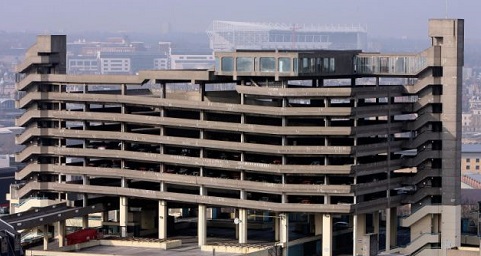Multi-storey car park
A car park is a designated area or building in which cars and other vehicles can be parked and left temporarily. In American English, it is referred to as a ‘parking lot’. Car parks are a common feature of the built environment, and often adjoin shopping centres, public buildings, schools, sports and entertainment venues, and so on. For more information, see Car park.
A multi-storey car park (MSCP) is a stacked car park that has multiple storeys, may be enclosed and can be an independent building.
Vehicles flow between floors by means of interior or exterior ramps, vehicle lifts or automated robot systems.
MSCPs must be designed with regard to the heavy and varying loads and other physical stresses that are imposed by moving vehicles. The most common structural system for MSCPs is a precast concrete frame or post-tensioned cast-in-place concrete frame. This involves structural wall panels, floors, beams, slabs, stairs, and columns. The design aim is to achieve as large a floor span as possible without requiring supporting columns as these restrict the available area for parking. The frame may be kept open to the elements or a façade can be installed to enclose or partially enclose the interior.
In terms of lighting design for new MSCPs, it must comply with BS 5489-1: 2003 and BS EN 12464-1:2002, and emergency lighting to pedestrian areas must comply with BS 5266-1. Lighting design must consider the prevention of crime, e.g. by avoiding spaces that are in shadow. Painting roofs and walls white or using polished concrete finishes can allow the number of luminaries to be reduced, thereby reducing the energy consumption of the building and maintenance costs.
Other design measures that can be incorporated to try and prevent crime include treating vulnerable areas with anti-graffiti coatings, use of ‘hostile architecture’ features, climbing plants, CCTV systems, access control systems and so on.
MSCPs are not commonly noted for their high quality of architectural design but there are a handful of exceptions. Two notable examples are the celebrated, yet under-threat, Welbeck Street car park in central London, and the car park attached to the Preston bus station. The Trinity Square car park (see top image) was both celebrated and reviled for its iconic Brutalist design, but was demolished in 2010.
[edit] Related articles on Designing Buildings
Featured articles and news
RTPI leader to become new CIOB Chief Executive Officer
Dr Victoria Hills MRTPI, FICE to take over after Caroline Gumble’s departure.
Social and affordable housing, a long term plan for delivery
The “Delivering a Decade of Renewal for Social and Affordable Housing” strategy sets out future path.
A change to adoptive architecture
Effects of global weather warming on architectural detailing, material choice and human interaction.
The proposed publicly owned and backed subsidiary of Homes England, to facilitate new homes.
How big is the problem and what can we do to mitigate the effects?
Overheating guidance and tools for building designers
A number of cool guides to help with the heat.
The UK's Modern Industrial Strategy: A 10 year plan
Previous consultation criticism, current key elements and general support with some persisting reservations.
Building Safety Regulator reforms
New roles, new staff and a new fast track service pave the way for a single construction regulator.
Architectural Technologist CPDs and Communications
CIAT CPD… and how you can do it!
Cooling centres and cool spaces
Managing extreme heat in cities by directing the public to places for heat stress relief and water sources.
Winter gardens: A brief history and warm variations
Extending the season with glass in different forms and terms.
Restoring Great Yarmouth's Winter Gardens
Transforming one of the least sustainable constructions imaginable.
Construction Skills Mission Board launch sector drive
Newly formed government and industry collaboration set strategy for recruiting an additional 100,000 construction workers a year.
New Architects Code comes into effect in September 2025
ARB Architects Code of Conduct and Practice available with ongoing consultation regarding guidance.
Welsh Skills Body (Medr) launches ambitious plan
The new skills body brings together funding and regulation of tertiary education and research for the devolved nation.
Paul Gandy FCIOB announced as next CIOB President
Former Tilbury Douglas CEO takes helm.
UK Infrastructure: A 10 Year Strategy. In brief with reactions
With the National Infrastructure and Service Transformation Authority (NISTA).























